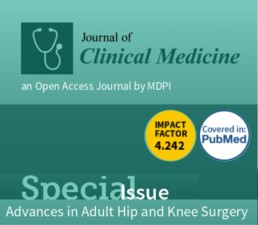In this Newsletter, EHS President Prof Siebenrock & EHS Member Dr Ahmad invite our members to contribute to the JCM Special Issue: “Advances in adult Hip and Knee Surgery”. Please read the full invitation HERE.
Meanwhile, our Past President, Dr Jean-Alain Epinette, comments on and draws brief conclusions following EFORT’s webinar in January that tackled the issue of Cobalt in Orthopaedic Implants, titled: “Relevance of Metal Carcinogenicity to Orthopedics: Controversies and Concerns”. Thank you to him for this contribution (below) an a hot topic affecting our community and thank you to EFORT President Li Felländer-Tsai and Immediate Past EFORT President Klaus-Peter Gunther for having approved the text.
Please save the date for two upcoming hip courses that EHS is collaborating in:
- 27th May 2022 Global Experts Hip Symposium EHS & Cleveland Clinic London (virtual event)
- 11th November 2022 EHS – SIDA – SIOT Conjoined symposium on THR for secondary arthritis & hip arthroscopy (in Rome)
And finally, below, we welcome new members to EHS.
Should Joint Prostheses Containing Cobalt Be Banned? By Dr Jean-Alain Epinette
in patients after joint replacement. Cobalt can be responsible for local toxicity (metallosis, hypersensitivity reaction, benign tumor) or systemic (cardiomyopathy, polycythemia, hypothyroidism, neurological disorders). The question of potential carcinogenicity for hip or mainly knee prostheses is not new, since it has been regularly mentioned for more than 10 years in scientific communications, but also in the “general public” press…
Apart from some studies [1-2], we can refer to the work published in the British Medical Journal in 2012, allowing the conclusion that “patients with metal-on-metal hip prosthesis do not present an increased risk of cancer, any more than the general population, in the 7 years that follow their implantation [3]. In 2016, the answer to the question “are cobalt hip prostheses dangerous?” published by the Liège toxicology department, confirmed the possibility of local toxicity, but the carcinogenic risk is not significantly different from that of the general population [4]. Regarding the risk of carcinogenesis, the Finnish registry in 2014 had not objectified an increased risk of cancer in 10,000 patients with a Metal-On-Metal prosthesis followed for an average of 4.6 years [5]. In fact, already in 1992, the 50-year clinical experience and history of the use of cobalt-chromium as an implant material in orthopedics, dentistry, and plastic surgery more than adequately establishes its safety and effectiveness, following comprehensive review literature on the subject… [6]
The rumor of a complete ban on these suddenly “dangerous” prostheses has recently stirred our orthopedic community… A joint MedTech Europe and EFORT report, published on August 14, 2018, was devoted to this issue of Cobalt in orthopedic implants (Joint Statement of EFORT and MedTech Europe’s Orthopedic Sector Group), and detailed the work of the European Commission within the framework of the new regulations for implantable devices (MDR-Medical Devices Regulation), the aim of which was both to inform any user that such a medical device contained a CMR (carcinogenic, mutagenic and toxic for reproduction), but also to ensure that the manufacturer has assessed any risk posed by such a substance. [7] Thus, as of October 1, 2021, cobalt is classified as a substance: carcinogen 1B, mutagen 2, toxic for reproduction 1B, pursuant to delegated regulation 2020/217 of the European Commission.
Nevertheless, in the application of European regulation 2017/745 relating to medical devices, devices containing cobalt in a concentration greater than 0.1% by mass fraction (m/m) must now meet the new safety and performance requirements established in Annex I, Chapter II, point 10.4. The manufacturers of a medical device that contains cobalt must therefore, from October 1, 2021: (1) justify the use of cobalt; this can be done for example by explaining why another material cannot replace it; (2) signal the presence of cobalt by specific labeling on the MD; (3) provide a notice informing of the residual risks.
confirm that the amount of cobalt released from cobalt-chromium alloys in orthopedic implants is only 1/25 of the exposure needed to detect any systemic effects in patients. Detailed analyzes of long-term published epidemiological studies and meta-analyses on large groups of patients covering more than 60 years of clinical use in orthopedics demonstrate no causal relationship between cobalt chromium or stainless-steel implants and the effects carcinogenic. The new legal obligation to label orthopedic implants containing cobalt does not change this. Demonstration of implant safety is an intrinsic prerequisite for obtaining regulatory approval and placing these implants on the European market [8].
for all of us, under the title “Relevance of Metal Carcinogenicity for Orthopedics: Controversies and Concerns”. . The themes covered allow us to take stock of the most recent data on the different topics covered: (1)Biochemical/Toxicological Background about Potential Carcinogenicity of Metals; (2) General Concern Regarding Cobalt in Surroundings and Initiatives to Overcome it; (3)Carcinogenic Assessment of Cobalt Containing Alloys in Medical Devices and (4)What is the Role of Registry Studies to Detect Potential Carcinogenic Hazards?… The REPLAY of this EFORT Webinar, held on 31 January 2022 is available online, DON’T MISS IT!
- Pijls BG., Meessen JMTA., Schoones JW., Fiocco M., Van der Heide HJL.; Sedrakyan A., Nelissen RGHH.; Increased Mortality in Metal-on-Metal versus Non-Metal-on-Metal Primary Total Hip Arthroplasty at 10 Years and Longer Follow-Up: A Systematic Review and Meta-Analysis; PLOS ONE | DOI:10.1371/journal.pone.0156051 June 13, 2016
- Wagner Ph, Olsson H, Lidgren L, Robertsson O, Ranstam J; Increased cancer risks among arthroplasty patients: 30 year follow-up of the Swedish Knee Arthroplasty Register; European Journal Of Cancer 4 7 ( 2 0 1 1 ) 1 0 6 1 –7 1
- BMJ 2012; 344 doi: 10.1136/bmj.e2383 Published 3 April 2012 Risk of cancer in first seven years after metal-on-metal hip replacement compared with other bearings and general population
- Mistretta V et al; “Are cobalt hip prostheses dangerous; Med Sci (Paris). 32(8-9): 732–8
- Mäkelä KT, Visuri T, Pulkkinen P, . Cancer incidence and cause-specific mortality in patients with metal-on-metal hip replacements in Finland. Acta Orthop 2014;85:32–8.
- Berkenstock OL. Issues concerning possible cobalt-chromium carcinogenicity: Orthop. 1992 Mar;24(3):265-78.
- Regulatory developments impacting the devices medicines that contain cobalt – ANSM Oct 2021 (in French)
- https://www.medtecheurope.org/resource-library/statement-with-efort-on-cobalt-in-orthopaedic-implants/
Credit Card payment
Credit card payments will be possible directly on our website very soon! Samantha will email you about it












